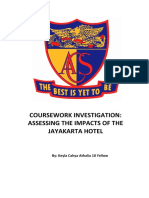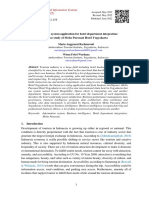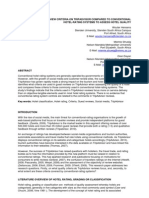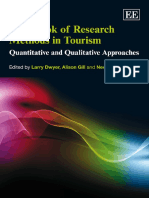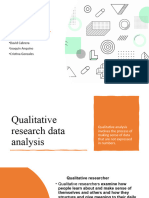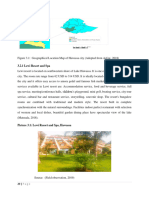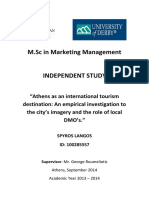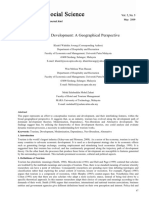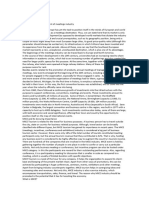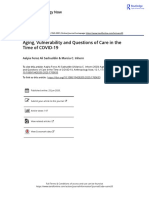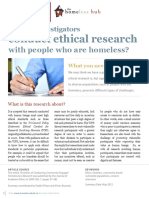APPLYING MATRIX DISPLAY IN QUALITATIVE DATA ANALYSIS
By:
Azilah Kasim, PhD1
Hisham Dzakiria, PhD2
UNIVERSITI UTARA MALAYSIA
MALAYSIA
ABSTRACT
This paper aims to demonstrate the application of matrix display in analyzing qualitative
data. The data used is from in-depth elite interviewing of hotel managers to investigate
the phenomena of Business Environmental and Social Responsibility in the hotel sector.
Using a case study approach, the data sought information on the awareness of Penang
hoteliers about their environmental and social responsibility, their attitudes towards this
emerging responsibility and their practices relating to environmental and social issues.
The demonstration on application of Matrix display on the data shows the usefulness of
this approach in ‘quantifying’ qualitative data, by going through the steps of converting
the volumes of qualitative information into themes, assigning numbers to interview
responses, aggregating the numbers to get a better picture and interpreting the results. In
the end the paper highlights some of the problems, issues and concerns in applying
matrix display in qualitative data analysis.
Keywords: case study approach, matrix display, qualitative data
Introduction
Qualitative is an approach that aims to discover the uniqueness of each particular situation by
explaining and understanding the context-specific phenomenon through naturalistic,
qualitative inquiry (Strauss & Corbin, 1990). In this inquiry, reality is seen as socially
constructed, holistic, multiple and contextual. It results in knowledge that takes full account of
the many, often complex and dynamic, interaction effects that take place in social settings,
evaluated by contrasting, comparing and classifying the object of study (Miles and Huberman,
1984; Locke, Spirduso and Silverman, 1987). In tourism, the qualitative approach is useful for
understanding an emerging social phenomenon such as hotel responsiveness to environmental
and social responsibility issues. Its holistic nature allows the researcher to construct reality
based on interpretations of the context while its flexible nature permits the researcher to
design qualitative investigation methods deemed most suitable for the context.
1
Faculty of Tourism, Hospitality and Environmental Management, Universiti Utara Malaysia
2
Faculty of Communication and Modern Languages, Universiti Utara Malaysia
�However, the inductive and grounded nature of qualitative approach does not mean that it is
always unstructured. A pre-structured methodology is essential to facilitate triangulation of data.
Thus, a protocol allows comparability of data and justifies data collection time constraints. As
warned by Miles and Huberman (1994: 17):
Loosely designed studies make good sense when experienced researchers have plenty of time and
are exploring exotic cultures, understudied phenomena, or very complex social phenomena. But if
you are new to qualitative studies and are looking at a better-understood phenomenon within a
familiar culture or subculture, a loose inductive design is a waste of time. Months of fieldwork and
voluminous case studies may yield only a few banalities.
Aggregated data on responsiveness of Pulau Pinang’s hotel sector towards BESR
This article refers to the use of qualitative approach to research Business Environmental
and Social Responsibility in the hotel sector of Pulau Pinang, Malaysia. The protocol was
based on the following themes: 1) awareness of the relevance of environmental and social
issues in the hotel sector, 2) hotel emphasis, reactions and current practices in relation to
environmental and social issues, 3) possible motivating or driving factors in hotel’s BESR, and 4)
possible obstacles or barriers of hotel’s BESR. To complete the inquiry, information such as hotel
profile as well as outside agencies’ initiatives and outlook about BESR was also solicited.
Data analysis process fits closely with what Miles and Huberman (1994: 9) termed as
‘fairly classic set of analytic moves’used across different qualitative research types.
These moves are 1) affixing codes to a set of field notes drawn from observations and
interviews; 2) noting reflections or other remarks in the margins; 3) sorting and sifting
through these materials to identify similar phrases, relationships between variables,
patterns, themes, distinct differences between subgroups, and common sequences; 4)
isolating these patterns and processes, commonalities and differences, and taking them
out to the field in the next wave of data collection; 5) gradually elaborating a small set of
generalizations that cover the consistencies discerned in the database; and confronting
those generalizations with a formalized body of knowledge in the form of construct or
theories.
The complex and massiveness of the research’s qualitative data require some form of
systematic reduction to assist understanding. Matrix display has been chosen as a way to
achieve this because it is a system that requires thoughtfulness about what portions of
data are useful for answering research questions and a comprehensive analysis that
include all relevant information (Miles and Huberman, 1994). In addition, it provides
avenue for a coherent and focused data organization.
The purpose of this exercise is essentially to lay out data to see ‘what is there’ about the
general relationships and/or trends about the issue being studied. Thus, a partially ordered
matrix is developed by placing the data in rows and columns that represent descriptive
categories. A value of 3 is given for positive responses that are in nature reinforcing the
underlying ideas implied by the question. In contrast, a value of 1 is for negative
responses that are in nature contesting the underlying ideas implied by the question.
Values are then aggregated and divided by the number of questions to obtain the average
�value for each category. The totals are calculated to provide a ‘score’ for each hotel, and
are compared to the profile of each hotel.
Box 1a through 1i: Matrix display for qualitative values – ranking legend, hotel code and
coding scheme
RANKING LEGEND
3 = Positive response i.e. answers that are in nature reinforcing the underlying ideas implied by the
question
1 = Negative response i.e. answers that are in nature contesting the underlying ideas implied by the
question
HOTEL CODE:
Mutiara Beach Resort (5 star rating)
Shangri La’s Rasa Sayang Resort (5 star rating)
Shangri La’s Golden Sand Resort (4 star rating)
Copthorne Orchid Hotel (4 star rating)
Casuarina Beach Hotel (4 star rating)
Vistana Hotel Pulau Pinang(4 star rating)
Seri Malaysia Hotel Pulau Pinang(3 star rating)
Bayview Beach Resort (4 star rating)
The Gurney Hotel (4 star rating)
City Bayview Hotel (4 star rating)
Cititel (4 star rating)
Sunway Hotel (3 star rating)
Midtowne Hotel (2 star rating)
Fortuna Hotel (no star)
Garden Inn Hotel (2 star rating)
Hotel Continental (2 star rating)
Agora Hotel (no star)
Berjaya Georgetown Hotel (4 star rating)
CODING SCHEME - AWARENESS
3 = firm demonstrates high awareness about the environmental impact of a hotel operation on the
environment. Able to incorporate relevant environmental issues including solid waste, wastewater
and resource utilization and their relation to a hotel’s day to day operation
2 = firm demonstrates an average awareness about the environmental impact of a hotel operation
1 = firm demonstrates poor awareness about the environmental impact of a hotel operation
Physical effect: firm responses to show awareness about the environmental effects of a hotel
operation
Social effect: firm responses to show understanding on the social responsibility of a hotel firm
Need for environmental effort: firm responses on the need and ways of dealing with environmental
issues
Need for community effort: firm responses on the need and ways of dealing with social
responsibility
Certification: firm responses to show awareness on a range of environmental/social certification
available
CODING SCHEME - PERCEPTION
3 = firm provides optimistic views on the strategic value of environmental and social responsibility
�measures in hotel business
2 = firm were either undecided or did not provide strong views about the issues
1 = firm were pessimistic about the issues
Strategic value of environmental initiative: responses to show firm’s perception about the business
value of being environmentally-friendly
Strategic value of community initiative: responses to show firm’s perception about the business
value of being community-friendly
Strategic value of employee-relation initiatives: responses to show firm’s perception about the
business value of being employee-friendly
Optimism about green hotels: responses to show positive reaction to the future of environmentally-
friendly hotel
Optimism about relationship between green measures and service quality: responses to show
positive reaction to the relationship between environmentally-friendly measures and the service
quality of a hotel
Value of environmental/environmental and social certification: responses to indicate perceptions on
the value of certification for hotel
CODING SCHEME - ATTITUDE
3 = firm provides positive reactions towards the importance and relevance of environmental and
social responsibility
2 = firm provides mixed reactions towards the importance and relevance of environmental and
social responsibility
1 = firm provides negative reactions towards the importance and relevance of environmental and
social responsibility
Integration of environmental and social issues in decision-making: responses to indicate the
integration of environmental and social issues in decision-making
Green management of supplier: responses to indicate any measures to manage suppliers based on
environmental and social issues
Importance of employee participation: responses to indicate the value given to employees’ voice in
hotel management
Importance of employees health and safety: responses to indicate value given to employees’ health
and safety related issues
CODING SCHEME - DRIVER
3 = firm indicates that there is pressure for hotel to show environmental and social responsibility
2 = firm is undecided or not knowledgeable about issues
1 = firm indicates that there isn’t any pressure for hotel to show environmental and social
responsibility
Drive from shareholders: responses to indicate if there are any drive from shareholders regarding
environmental and social responsibility issues
Drive from the local community: responses to indicate if there are any demand from the local
community regarding environmental and social responsibility issues
Drive from employees: responses to indicate if there are any demand from the employees regarding
hotel’s environmental and social responsibility
Drive from owners: responses to indicate if there any communication from the owners regarding
hotel’s environmental and social responsibility
Drive from guests: responses to indicate if there any demand from the hotel guests for hotels to
demonstrate environmental and social responsibility
International pressure: responses to indicate if there are any communication from international
tourism agencies regarding environmental and social issues
�Regional pressure: responses to indicate if there are any communication from regional tourism
agencies regarding environmental and social issues
Drive from the headquarters: responses to indicate if there are any pressure from hotel’s headquarter
regarding environmental and social issues
Drive from the regulatory bodies: responses to indicate if there are any pressure from the formal
regulating bodies regarding environmental and social issues
Drive from the industry: responses to indicate if there are any pressure from the trade associations
regarding environmental and social issues
Drive from the economic perspective: responses to indicate if there are any economic reasons for
dealing with environmental and social issues
CODING SCHEME - BARRIER
1 = firm indicates strongly the problems for hotel to show environmental and social responsibility
2 = firm do have any strong views regarding the matter
3 = firm indicates no problems associated with hotel’s ability to show environmental and social
responsibility
Barriers to environmental responsiveness: responses to indicate the problems that stop hotel’s from
being environmentally friendly
Barriers to community development responsiveness: responses to indicate the obstacles of reaching
towards the community
Barriers to employee-relation responsiveness: responses to indicate the problems of being
employee-friendly
Integrating ethics into decision-making
CODING SCHEME - POSSIBLE ROLE
3 = firm has strong positive views regarding the possible role of various agencies in promoting
environmental and social responsibility among hotels
2 = firm does not have any strong views regarding the matter
1 = firm has strong negative views regarding the possible role of various agencies in promoting
environmental and social responsibility among hotels
Role of the formal regulating bodies: responses to indicate industry’s perspective on the role of the
government regarding environmental and social issues
Role of the industry: responses to indicate perspective relating to the role of trade associations
regarding environmental and social issues
Role of informal regulating bodies: responses relating to the role of NGO/CBO regarding
environmental and social issues and hotels
Role of the headquarters: responses relating to the role of the headquarters regarding environmental
and social issues (if relevant)
Role of the global agencies: responses relating to the role of international bodies regarding
environmental and social issues and hotels
�CODING SCHEME - ENVIRONMENTAL MEASURES
3 = firm is taking substantial to more than moderate environmental initiatives in its operation
2 = firm is taking some environmental initiatives in its operation
1 = firm is not taking any environmental initiatives in its operation
Water measure: firm’s response in relation to existing water quantity/quality saving measures taken
by hotel
Energy measure: firm’s response in relation to existing energy saving measures taken by hotel
Wastewater measure: firm’s response in relation to existing wastewater measure taken by hotel
Solid waste measure: firm’s response in relation to existing solid waste measure taken by hotel
Monitoring of environmental effort: firm’s response in relation to existing monitoring efforts on
hotel’s environmental initiatives
Communication of environmental effort: firm’s response in relation to existing communication
efforts on hotel’s environmental initiatives
Local culture measure: firm’s response in relation to existing measures to educate guests about local
cultures
Education of guest measure: firm’s response in relation to existing measures to educate guests on
environmental and social issues
Community outreach measure: firm’s response in relation to existing measures to reach the
surrounding community
Philanthropic measure: firm’s response in relation to existing philanthropic measures taken by hotel
CODING SCHEME - SOCIAL MEASURES
3 = firm is taking substantial to more than moderate social initiatives in its operation
2 = firm is taking some social initiatives in its operation
1 = firm is not taking any social initiatives in its operation
Monitoring of social effect: firm’s response in relation to existing monitoring effort on the social
aspect of a hotel’s operation
Communication of social effect: firm’s response in relation to existing communication effort
relating to the social effect of a hotel’s operation
Employee health measure: firm’s response in relation to existing measures to care for employee’s
health
Employee safety measure: firm’s response in relation to existing measures to assure safety of
workers
Work satisfaction measure: firm’s response in relation to existing measures to enhance work
satisfaction
Monitoring of employee-relation measure: firm’s response in relation to existing measures to
monitor employee-relation measures
Communication of employee-relations measure: firm’s response in relation to existing
communication effort relating to employee-relation measures
AA. Availability of documented stand on environmental and social issues: company’s response in
relation to existing document available about a company’s stand on environmental and social issues
�Table 11a through 11b: Hotel response to environmental and social responsibility (non-aggregated values)
Awareness importance attitude driver barrier Role Environmental responsibility
measures
a b c d e f g h i j k l m n o p q r s t u v w x y z A B C D E F G H I J K L M N O P Q R S
co
.
1 2 2 2 2 2 2 2 3 3 2 2 2 1 2 3 1 1 1 2 3 1 1 2 2 2 3 2 2 1 2 3 1 1 2 2 3 2 2 3 2 2 2 2 3 2
2 2 2 3 2 3 3 3 3 3 3 3 3 1 3 3 1 1 1 3 3 1 1 3 2 2 3 2 2 1 3 3 1 1 3 2 3 3 3 3 3 3 3 3 3 2
3 2 2 3 2 3 3 3 3 3 3 3 3 3 3 3 1 1 1 3 3 1 1 3 2 2 3 2 2 1 3 3 1 1 3 2 3 3 3 3 3 3 3 3 3 2
4 2 2 3 2 2 3 2 2 3 2 1 2 1 2 3 1 1 1 2 3 1 1 2 2 1 3 2 2 1 1 3 1 1 2 2 2 3 3 3 2 2 2 2 2 2
5 2 2 2 2 1 3 2 2 1 1 1 1 1 2 3 1 1 1 2 3 1 1 2 2 1 3 2 2 2 1 3 1 2 2 2 1 2 2 3 2 2 2 2 2 2
6 2 2 1 2 1 2 2 3 1 1 1 1 1 2 3 1 1 1 1 1 1 1 1 2 1 2 2 2 1 1 2 1 1 2 1 2 2 2 1 2 2 2 2 2 2
7 2 2 2 2 1 2 2 2 1 1 1 1 1 2 3 1 1 1 1 1 1 1 1 2 1 2 2 2 1 2 2 1 1 2 1 1 2 2 1 2 2 3 1 2 2
8 2 2 3 2 2 3 2 3 2 2 2 3 1 2 3 1 1 1 2 3 1 1 2 2 2 3 2 2 1 2 3 1 2 3 2 3 3 3 3 2 2 3 2 2 2
9 2 2 1 2 2 1 2 2 1 1 1 1 1 2 3 1 1 1 1 1 1 1 1 2 1 2 2 2 1 2 1 1 1 2 1 1 2 2 2 2 2 1 1 2 2
10 2 2 1 2 3 2 2 2 1 1 3 1 1 2 3 1 1 1 1 1 1 1 1 2 1 2 2 2 1 2 2 1 1 2 1 2 2 2 3 2 2 1 1 2 2
11 2 2 2 2 3 3 2 2 3 3 3 1 1 2 3 1 1 1 2 2 2 2 1 2 3 3 1 2 1 2 3 1 1 2 1 2 2 2 3 2 2 2 2 2 2
12 2 2 1 2 2 2 2 3 1 1 2 1 1 2 3 1 1 1 1 1 1 1 1 1 1 1 1 2 1 1 2 1 2 2 1 3 2 2 2 2 2 3 1 2 2
13 2 2 2 2 1 1 2 2 1 1 2 1 1 2 3 1 1 1 1 1 1 1 1 1 1 1 1 2 1 1 2 1 1 1 1 2 2 2 1 2 2 1 1 2 2
14 2 2 1 2 1 1 2 2 1 1 1 1 1 2 3 1 1 1 1 1 1 1 1 1 1 1 1 2 1 1 2 1 1 1 1 1 2 2 1 1 1 1 1 1 2
15 2 2 1 2 1 1 1 2 1 1 1 1 1 2 3 1 1 1 1 1 1 1 1 1 1 1 1 2 1 1 2 1 1 1 1 1 2 2 1 1 1 1 1 2 2
16 2 2 1 2 1 1 1 2 1 1 1 1 1 2 3 1 1 1 1 1 1 1 1 1 1 1 1 2 1 1 2 1 1 1 1 1 2 2 1 1 1 1 1 2 2
17 2 2 1 2 1 1 1 2 1 1 1 1 1 2 3 1 1 1 1 1 1 1 1 1 1 1 1 2 1 1 2 1 1 1 1 1 2 2 1 1 1 1 1 1 2
18 2 2 2 2 1 1 1 2 1 1 1 1 1 2 3 1 1 1 1 1 1 1 1 2 1 1 1 2 1 1 2 1 1 2 1 1 2 2 1 1 1 1 1 2 2
LEGEND
3 = Positive response i.e. answers that are in nature reinforcing the underlying ideas implied by the question
1 = Negative response i.e. answers that are in nature contesting the underlying ideas implied by the question
�Table 11b
Social responsibility
measures
T U V W X Y Z A
A
Co.
1 1 3 3 3 2 2 2 2
2 3 3 3 3 2 2 2 2
3 3 3 3 3 2 2 2 1
4 1 1 2 2 2 2 2 1
5 1 1 2 2 2 2 2 2
6 1 1 2 2 2 2 2 1
7 1 1 3 3 2 2 2 2
8 1 1 2 2 2 2 2 1
9 1 1 2 2 2 2 2 2
10 1 1 3 3 2 2 2 2
11 1 1 3 3 2 2 2 1
12 1 1 2 2 2 2 2 1
13 1 1 2 2 2 2 2 1
14 1 1 2 2 2 2 2 1
15 1 1 2 2 2 2 2 1
16 1 1 2 2 2 2 2 1
17 1 1 2 2 2 2 2 1
18 1 1 2 2 2 2 2 1
LEGEND
3 = Positive response i.e. answers that are in nature reinforcing the underlying ideas implied by the question
1 = Negative response i.e. answers that are in nature contesting the underlying ideas implied by the question
�Table 12: Aggregated value of hotel response to environmental and social responsibility (average values and ranking)
Awareness importance attitude driver barrier Role Environmental Social OVERALL HOTEL BASIC PROFILE
responsibility responsibility RANKING
measures measures
a-e f-k l-q r-B C-F G-K L-S T-AA Rating Ownership chain Type
Co.
1 2 2.7 1.8 1.7 1.7 1.8 2 2.2 1.99 (4) 5 MALAYSIAN YES RESORT
2 2.4 3 2.5 1.9 2 2 2.9 2.5 2.45 (1) 5 HONG KONG YES RESORT
3 2.4 3 2.8 1.9 2 2 2.9 2.4 2.42 (2) 4 HONG KONG YES RESORT
4 2.2 2.2 2.2 1.6 1.5 1.8 2.3 1.6 1.92 (6) 4 SINGAPOREAN YES RESORT
5 1.8 1.7 2 1.6 1.7 1.6 2 1.7 1.76 (7) 4 MALAYSIAN YES RESORT
6 1.6 1.7 1.8 1.2 1.5 1.4 1.9 1.7 1.59 (11) 4 MALAYSIAN YES CITY
7 1.8 1.5 1.8 1 1.7 1.4 1.8 2 1.62 (9) 3 MALAYSIAN YES CITY
8 2.2 2.3 2.3 1.7 1.7 2.2 2.5 1.7 2.07 (3) 4 MALAYSIAN YES RESORT
9 1.8 1.3 1.7 1.2 1.7 1.2 1.7 1.8 1.55 (12) 4 MALAYSIAN YES RESORT
10 2 1.8 1.8 1.2 1.7 1.4 1.9 2 1.72 (8) 4 MALAYSIAN YES CITY
11 2.2 2.7 1.8 1.8 1.1.5 1.6 2.2 1.9 1.96 (5) 4 MALAYSIAN YES CITY
12 1.8 1.8 1.8 1 1.2 1.6 2.1 1.6 1.61 (10) 3 MALAYSIAN YES CITY
13 1.8 1.5 1.6 1 1.2 1.2 1.7 1.6 1.40 (13) 2 MALAYSIAN NO CITY
14 1.6 1.3 1.6 1 1.2 1.2 1.3 1.6 1.35 (15) - MALAYSIAN NO CITY
15 1.6 1.2 1.5 1 1.2 1.2 1.3 1.6 1.32 (17) 2 MALAYSIAN NO CITY
16 1.6 1.3 1.5 1 1.2 1.2 1.3 1.6 1.33 (16) 2 MALAYSIAN YES CITY
17 1.6 1.2 1.5 1 1.2 1.2 1.2 1.6 1.31 (18) - MALAYSIAN NO CITY
18 1.8 1.2 1.5 1 1.2 1.4 1.3 1.6 1.37 (14) 4 MALAYSIAN YES CITY
LEGEND
3 = Positive response i.e. answers that are in nature reinforcing the underlying ideas implied by the question
1 = Negative response i.e. answers that are in nature contesting the underlying ideas implied by the question
�Interpreting the Matrix Data
The matrix data highlights several key findings i.e. 1) that hotel respondents generally fit
along a line of equilibrium in terms of their responsiveness towards BESR. On one
extreme of the equilibrium, firms 2,3,8 and 1 comprise the most responsive hotels. On the
other extreme, firms 14,16,15 and 17 are among the least responsive. Cross-comparing
the variables using hotel profile attributes shows that in terms of hotel rating, five and
four star hotels show more positive reactions towards BESR. There are mixed reactions
from the 3 star hotels and negative reactions from the hotels of 2 star and below
categories. This shows that hotel size affects its propensity towards BESR; 2) hotels
operated by international management firm are more inclined towards BESR whereas
hotels operated by national management firms show mixed reactions on the matter. This
suggests that a hotel’s management type also has an influence. Furthermore, chain hotels
are more inclined towards BESR than stand alone hotels, indicating that chain operation
also has effect on a hotel’s stand on BESR issues; 3) resort hotels are more inclined
towards BESR than city hotels. This seems to indicate that ‘type’ of hotel has an
influence on a hotel’s propensity towards BESR; and 4) that size, management type and
guest type are the major determinants of Pulau Pinang hotels’ general responsiveness
towards BESR.
Nevertheless, the findings only provide a surface level outlook on hotel’s propensity
towards BESR issues. Thus, it would be misleading to accept them without scrutinizing
the findings a little more in depth with data from other sources. For example, finding 1 is
meaningless unless matched with arguments in the literature that large, international
enterprises affiliated to a chain generally manifest a reasonably high level of BESR due
to the nature of big business itself. One argument would by Henriques and Sardosky
(1996) who justify why big firms are more inclined to demonstrate higher ‘responsible’
image including: 1) the availability of funding for such activities, 2) the need for extra
coordination to ensure standards and quality – firm’s policies on environment and social
issues would provide the necessary ‘coordinating tool’ for big firms to manage
effectively, 3) the ‘visibility’ of big firms in the eye of the public and expectation on
them to lead the industry in new ventures and finally, that 4) big firms’ corporate
standard to have corporate social investment funds whether discretionary, structured or
located in a separate fund. Another is by Zadek at. al. (1997) who propose that the bigger
the firm, the more exposed is its environmental stance to the public eye. Smaller
enterprises are less likely to have BESR programs as they are less demanded in terms of
accountability. That is probably the justification why small ‘stand alone’ firms are also
less inclined towards BESR compared to other similar size chain firms, as indicated in
the findings.
Another example relates to finding 3. In this case, the finding is more meaningful when
matched against elite interviewing data which reveals that size and characteristics of
those hotels play a role in BESR responsiveness. Resorts are secluded in a big area of
land with many of its own restaurants and outlets. Shangri La Rasa Sayang hotel for
example, requires 15 acres of land to house its garden landscape, restaurants and its 514
rooms hotel building. Thus, it is far more ‘visible’ as the point source of any form of
�pollution it may generate. In contrast, city hotels only have the area for the hotel building,
often ‘sandwiched’ between many other enterprises, hindering the visibility of the source
of pollution. They also lack laundry facility and big food and beverage (F&B) outlets.
This effectively reduces the amount of direct environmental impact city hotels have onto
the environment thereby making them less visibly accountable compared to the beach
hotels and resorts.
Another reason why resorts appear to be more inclined towards BESR is the nature of
tourists that patron this type of hotels. According to many of the hotel respondents,
international tourists, mainly from the West, prefer to patron resorts especially the ones in
Batu Ferringhi. This type of tourists have more discerning taste as far as environmental
issues are concerned and are more vocal in their thoughts and feelings. In other words,
they would not hesitate to complain if they are not satisfied and hotel management has to
pay attention to such complaints as part of their customer relation efforts. The foreign
tourists are also ‘picky’ on environmental issues and more receptive of environmental
measures that may be introduced by the management. In contrast, city hotels attract more
domestic or regional business travelers from countries such as Singapore and Thailand.
This type of tourists is generally less environmentally conscious, preferring ‘value for
money’ places to fulfill their immediate needs (rest, leisure) instead.
Conclusion
Matrix is a way to organize the volumes of data often generated by a qualitative research.
It allows for data comparison and put ‘value’ to each research findings. This enables a
clearer perspective because the data can now be compared and preliminary conclusions
can be made. However, a matrix does not allow a thick description of a phenomenon. Its
simplicity and ease of use does not permit it to be used in isolation. Therefore, it must be
supported and triangulated with data from other sources such as personal observation,
elite interviewing, secondary data analysis and documentary analysis. In addition, the
assignment of value to data is also not totally value free because it is done by people not
machines. Thus, data interpretation is subject to the interpreter’s understanding and prior
knowledge on the subject. In other words, researchers and not their assistants are most
qualified to interpret the data accurately. Overall however, matrix is a useful tool to
reduce the massiveness of qualitative data and provide a base from which a researcher
can begin analyzing his or her data.
Reference
Miles, M. & M. Huberman (1994). Qualitative Data Analysis. 2nd ed.. Sage: California.
Strauss A. & Corbin J. (1990). Basics of Qualitative Research: Grounded Theory – Procedures
and Techniques. California: Sage.
Locke, L., Spirduso, W., & Silverman, S.J. (1993). Proposals that Work (3rd ed.) Newbury Park.
CA: Sage.
�Henriques, I & Sardosky, P. (1996). The determinants of an environmentally responsive firm: An
empirical approach. Journal o f Environmental Economics and Management. 30: 381-395
Zadek, S., Puzan, P. & Evans, R. (1997). Building corporate accountability: Emerging practices
in Social and Ethical Accounting, Auditing and Reporting. Zadek, S. (Ed.) London,
England:Earthscan

